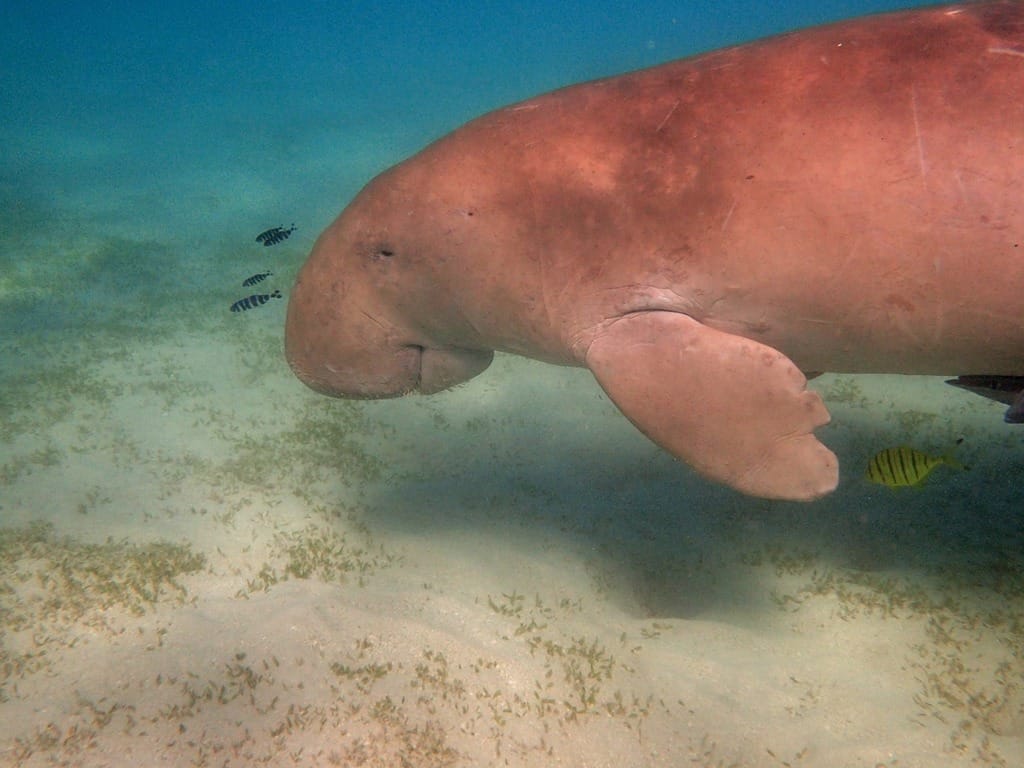
Dugong conservation is essential for protecting the dugong (Dugong dugon), a gentle marine mammal often referred to as the “sea cow.” These creatures play a vital role in maintaining the health of seagrass ecosystems. Listed as vulnerable by the International Union for Conservation of Nature (IUCN), they face threats such as habitat loss, hunting, and human-induced disturbances. Found across the Indo-Pacific, their populations are under threat, and urgent efforts are necessary to ensure their survival. To swim with these Gentle Giants in accordance to the Dugong Conservatory please register in advance as space is limited by the Conservatory to 30 pax a day.
Table of Contents
The Dugong’s Habitat: From Coron to El Nido and Beyond
Dugongs inhabit shallow coastal waters where seagrass beds, their primary food source, thrive. These habitats span regions from East Africa to the Pacific Islands, including the Philippines, a biodiversity hotspot.
In the Philippines, Coron and El Nido in Palawan are prime areas for spotting dugongs. These locations boast pristine waters and lush seagrass meadows, offering an ideal environment for the species. Coron, renowned for its stunning shipwreck diving sites, and El Nido, famous for its limestone cliffs and turquoise lagoons, together provide a unique opportunity for travelers to witness the beauty of marine life, including dugongs, while exploring the route from Coron to El Nido.
Challenges Facing Dugong Populations
The IUCN highlights several threats to dugong populations, including:
- Habitat Degradation: Coastal development, pollution, and destructive fishing practices damage seagrass beds, reducing available food sources.
- Hunting and Poaching: Dugongs are targeted for their meat, oil, and tusks in some regions, further endangering their populations.
- Bycatch: Accidental capture in fishing nets is a significant cause of dugong mortality.
- Boat Strikes: Increased marine traffic poses a direct threat to these slow-moving animals.
The Importance of Conservation
Protecting dugongs requires a multi-faceted approach, including habitat preservation, policy enforcement, and community education. Seagrass restoration projects, marine protected areas, and sustainable tourism initiatives are vital to safeguarding these animals and their ecosystems.
Sustainable Tourism: A Path to Conservation
Tourism, when managed responsibly, can contribute to conservation efforts. By raising awareness about dugongs and their habitats, travelers can play an active role in protecting marine biodiversity. For instance, eco-friendly practices such as avoiding plastic waste, respecting marine wildlife, and supporting local conservation projects can make a significant difference.
Coron and El Nido have embraced sustainable tourism by promoting activities like snorkeling, diving, and eco-tours that prioritize environmental preservation. Visitors are encouraged to follow guidelines to minimize their impact on marine life, ensuring that future generations can continue to enjoy these natural wonders.
Best Diving Philippines: Exploring Marine Wonders
For travelers seeking unforgettable diving experiences, Best Diving Philippines offers exceptional opportunities to explore the underwater world while promoting sustainability. With a focus on eco-tourism, their tours provide insights into marine conservation and the importance of protecting species like the dugong.
The route from Coron to El Nido, in particular, is a must-visit for diving enthusiasts. Along this journey, adventurers can discover vibrant coral reefs, diverse marine species, and the serene presence of dugongs in their natural habitat. By choosing responsible tour operators like Best Diving Philippines, visitors can support conservation efforts while enjoying the beauty of Palawan’s marine ecosystems.
How You Can Help
As a traveler, you can contribute to dugong conservation in several ways:
- Choose Sustainable Operators: Support eco-friendly tour providers that prioritize marine conservation.
- Follow Guidelines: Respect marine wildlife and adhere to regulations designed to protect fragile ecosystems.
- Reduce Your Carbon Footprint: Minimize waste, use reef-safe sunscreen, and opt for eco-conscious travel options.
- Spread Awareness: Share your experiences and knowledge about dugongs and marine conservation with others.
The Future of Dugong Conservation
The survival of dugongs depends on collective efforts from governments, conservation organizations, local communities, and travelers. By prioritizing sustainable practices and raising awareness, we can protect these gentle giants and the seagrass ecosystems they call home.
Exploring the route from Coron to El Nido offers a chance to witness the beauty of Palawan’s marine biodiversity while contributing to the preservation of its delicate ecosystems. Let us embrace sustainable tourism and ensure that the dugong continues to grace our oceans for generations to come.

